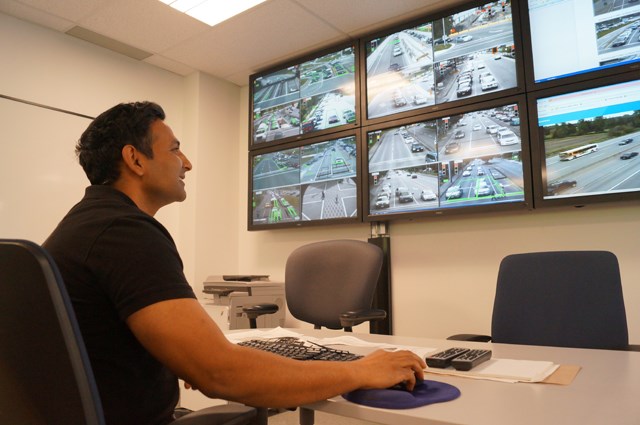If you were half a minute late heading southbound on Russ Baker Way on Wednesday, April 29 at around 3 p.m. that was because Richmond’s traffic signal systems supervisor, Jeff Bycraft, was testing the pedestrian signal, causing an extended red light for cars turning onto Gilbert Road.
No one was crossing the street; you weren’t going crazy. Bycraft is in charge of the city’s 325 traffic signals, from his Traffic Management Centre office chair on the third floor of the Richmond City Hall annex.
With about 70,000 more people expected to live in Richmond over the next 25 years, traffic management for a city that has limited space to expand its road network will become that much more important; in 2014 Richmond added 4,183 additional registered vehicles to its roads, the most ever in one year since at least 2000, according to the Insurance Corporation of B.C.
Long gone are the days when Bycraft, a 30-year veteran of transportation planning, stood on the corner of an intersection counting cars with a clicker.
Now, Bycraft also oversees some 150 non-recording, traffic-detection cameras that monitor 38 intersections in the city.
Bycraft and his crack team of traffic managers have a growing eye on the city.
This year, a new set of cameras will be installed at each intersection along Steveston Highway. Slowly, with the installation of fibre optic cables, other high-traffic streets will have cameras installed, and each new full traffic signal in the city (such as the three soon to be installed along No. 2 Road) will also have cameras outfitted at a cost of up to $40,000 per intersection.
“We didn’t realize how powerful these cameras would be in monitoring traffic,” said Bycraft. The cameras can detect traffic and assist the in-ground electronic sensors commonly seen as black loops on the pavement. During construction season many of the in-ground sensors are damaged, adding to the traffic woes, so Bycraft notes they’re particularly valuable during the summer.
Better data allows Bycraft’s team to better analyze traffic. According to the City of Richmond, there are roughly 1,700 car counting detectors throughout the city, monitoring traffic flow in five-minute increments, 24 hours per day, 365 days per year. Bycraft expects to release citywide lane-by-lane data by 2016. It was last done in 2006.
The team sets times for each intersection signal accordingly, as well as determines signal coordination with other intersections. For instance, from 3 to 7 p.m., No. 2 Road southbound is coordinated to keep traffic moving from Sea Island into south Richmond.
Some intersections will change their operating parameters 10 times a day.
“Forty per cent efficiency is doing fairly well. Downtown Vancouver is probably at 60 per cent efficiency because of their one-way streets,” said Bycraft, noting the system is designed to prioritize busier streets.
Much of the system relies upon driving at or just slightly above the posted speed limit.
For instance, the system detects the “platoon” of cars, not outliers, said Bycraft. So, a driver that speeds ahead will likely need to stop at the next light until the cameras and sensors detect a batch of vehicles.
Sensors and cameras can spot a vehicle from 65 metres (four seconds) ahead of the red light. If there are no vehicles heading in the opposite direction at the intersection, from the same distance, the red light will turn green. Bycraft notes this system can avoid crashes since any subsequent drivers in the opposite direction shouldn’t be racing to beat the amber light by the time they approach it.
Moving forward, Bycraft said the challenge for him and his successors will be multi-mode travel, particularly in applying the system to bike lanes.



